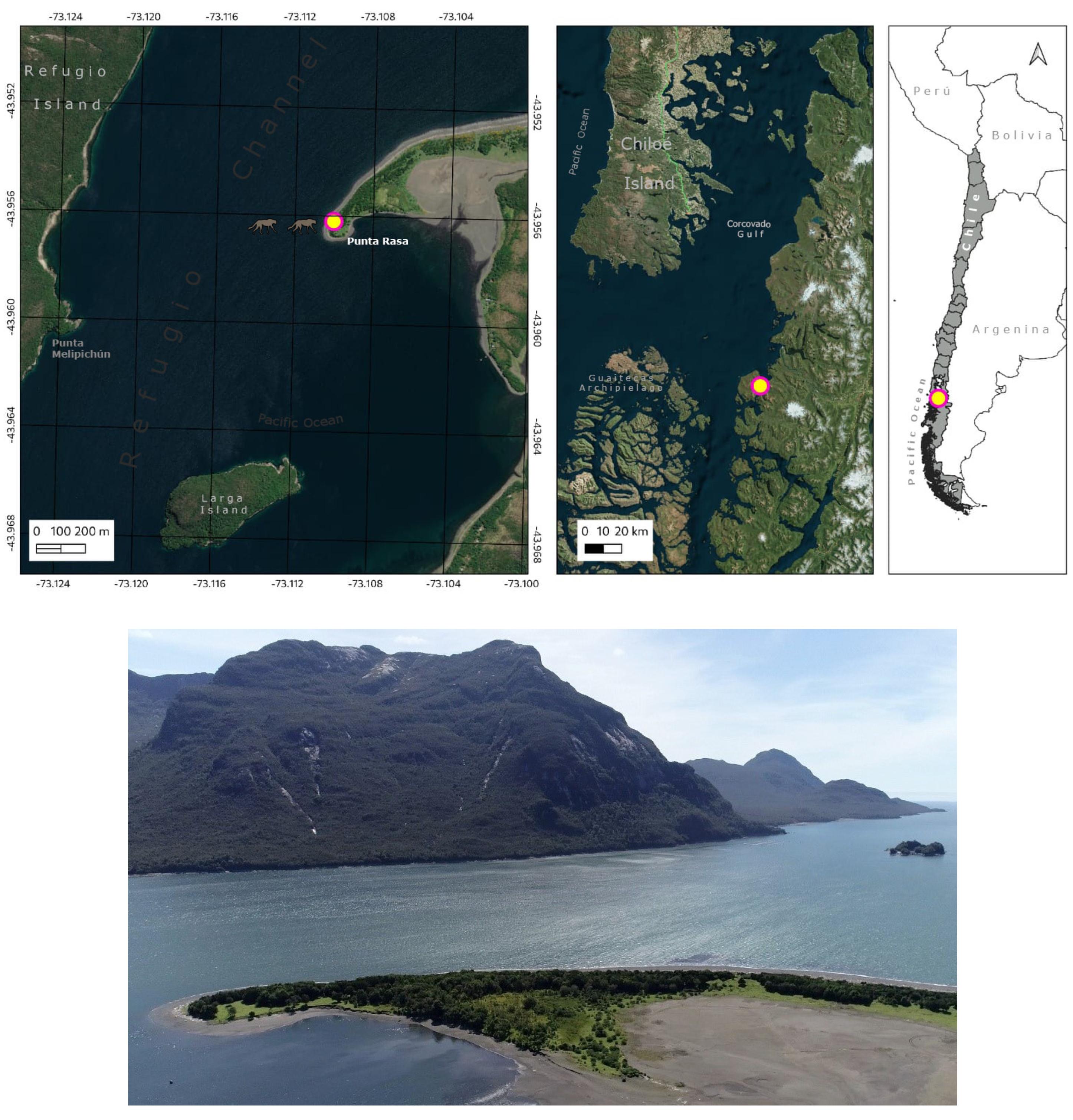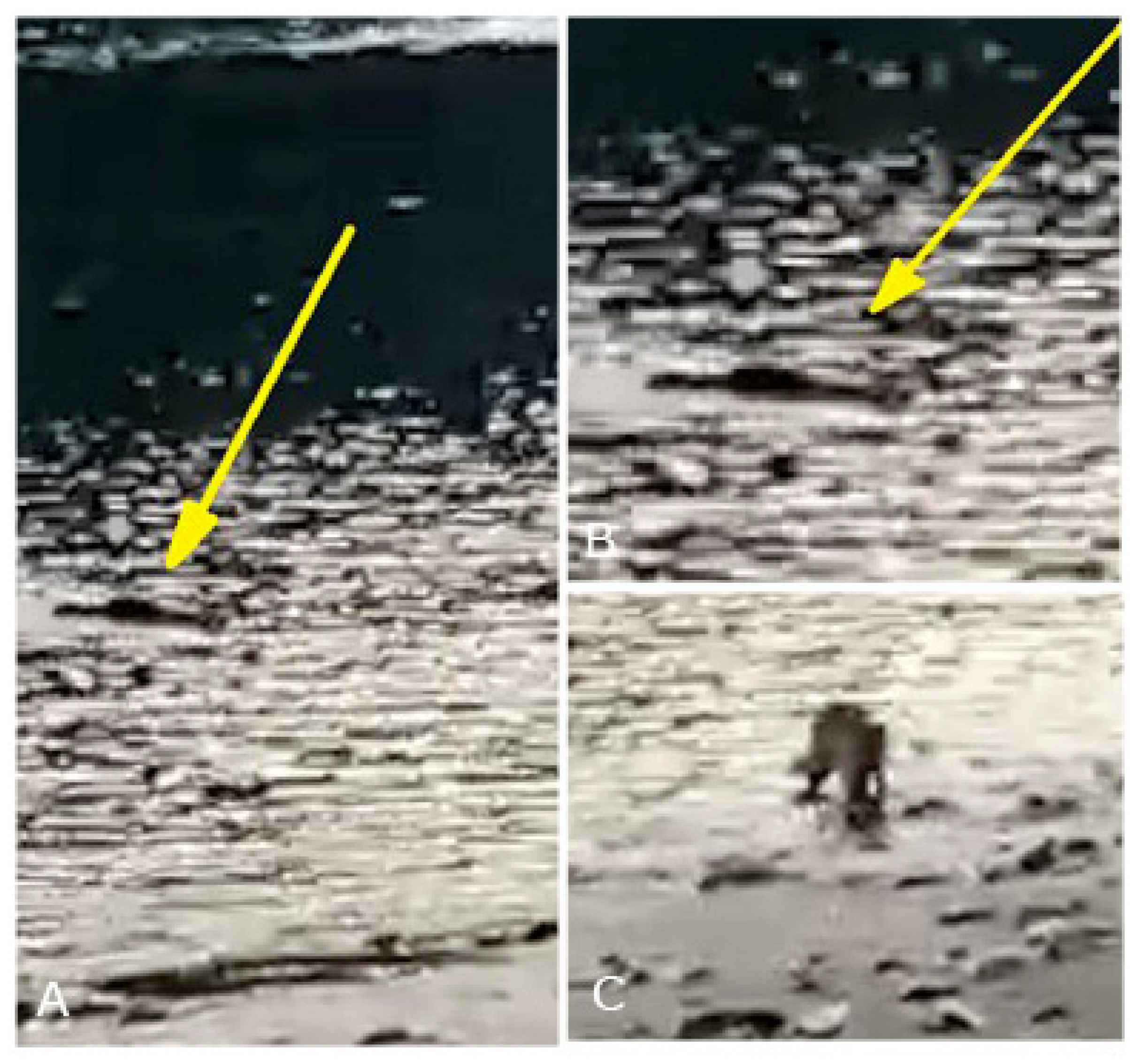An Audacious Maneuver: First Record of Leopardus guigna in the Marine Environment
Abstract
Simple Summary
Abstract
1. Introduction
2. Materials and Methods
3. Results
4. Discussion
5. Conclusions
Supplementary Materials
Author Contributions
Funding
Institutional Review Board Statement
Informed Consent Statement
Data Availability Statement
Acknowledgments
Conflicts of Interest
References
- Nascimento, F.G.; Jilong, C.; Feijó, A. Taxonomic revision of the pampas cat Leopardus colocola complex (Carnivora: Felidae): An integrative approach. Zool. J. Linn. Soc. 2021, 191, 575–611. [Google Scholar] [CrossRef]
- Sunquist, M.E.; Sunquist, F. Wild Cats of the World; University of Chicago Press: Chicago, IL, USA, 2002. [Google Scholar]
- Redford, K.; Eisenberg, J. Mammals of the Neotropics, Volume 2. The Southern Cone: Chile, Argentina, Uruguay, Paraguay; University of Chicago Press: Chicago, IL, USA; 430p.
- Dunstone, N.; Freer, R.; Acosta-Jamett, G.; Durbin, L.; Wyllie, I.; Mazzolli, M.; Scott, D. Uso del hábitat, actividad y dieta de la guiña (Oncifelis guigna) en el Parque Nacional Laguna San Rafael, XI Región, Chile. Boletín Del Mus. Nac. De Hist. Nat. 2002, 51, 147–158. [Google Scholar] [CrossRef]
- Napolitano, C.; Larraguibel-González, C.; Cepeda-Mercado, A.A.; Vial, P.; Sanderson, J. New records of Leopardus guigna in its northern-most distribution in Chile: Implications for conservation. Rev. Chil. Hist. Nat. 2020, 93, 7. [Google Scholar] [CrossRef]
- Osgood, W.H. The Mammals of Chile; Field Museum of Natural History: Chicago, IL, USA, 1943; Volume 30, p. l–268. [Google Scholar]
- Cuyckens, G.A.E.; Morales, M.M.; Tognelli, M.F. Assessing the distribution of a Vulnerable felid species: Threats from human land use and climate change to the kodkod Leopardus guigna. Oryx 2014, 49, 611–618. [Google Scholar] [CrossRef]
- Dunstone, N.; Durbin, L.; Wyllie, T.I.; Freer, R.; Acosta, G.; Mazzolli, M.; Rose, S. Spatial organization, ranging behaviour, and habitat use of the kodkod (Oncifelis guigna) in southern Chile. J. Zool. 2002, 257, 1–11. [Google Scholar] [CrossRef]
- Sanderson, J.; Sunquist, M.E.; Iriarte, A. Natural history and landscape-use of guignas (Oncifelis guigna) on Isla Grande de Chiloé, Chile. J. Mammal. 2002, 83, 608–613. [Google Scholar] [CrossRef]
- Delibes-Mateos, M.; Díaz-Ruiz, F.; Caro, J.; Ferreras, P. Activity patterns of the vulnerable guiña (Leopardus guigna) and its main prey in the Valdivian rainforest of southern Chile. Mamm. Biol. 2014, 79, 393–397. [Google Scholar] [CrossRef]
- Kaiser, M.; Muñoz, P.A.; Guzmán, B.C. Overcoming barriers: Novel records of swimming behavior in Leopardus guigna. Gayana 2022, 86, 13–16. [Google Scholar]
- Johnson, W.E.; Franklin, W.L. Feeding and Spatial Ecology of Felis geoffroyi in Southern Patagonia. J. Mammal. 1991, 72, 815–820. [Google Scholar] [CrossRef]
- Altamirano, T.A.; Hernández, F.; de la Maza, M.; Bonacic, C. Güiña (Leopardus guigna) preys on cavity-nesting nestlings. Rev. Chil. De Hist. Nat. 2013, 86, 501–504. [Google Scholar] [CrossRef]
- Crawshaw, P.G. Comparative Ecology of Ocelot (Felis pardalis) and Jaguar (Panthera onca) in a Protected Subtropical Forest in Brazil and Argentina. Ph.D. Thesis, University of Florida, Gainesville, FL, USA, 1995. [Google Scholar]
- Elbroch, L.M.; Quigley, H.B. Snow Leopards: Biodiversity of the World: Conservation from Genes to Landscapes; Elsevier: Amsterdam, The Netherlands, 2016. [Google Scholar]
- Freer, R.A. The Spatial Ecology of the Güiña (Oncifelis guigna) in Southern Chile. Ph.D. Thesis, University of Durham, Durham, UK, 2004. [Google Scholar]
- Lynam, A.J.; Jenks, K.E.; Tantipisanuh, N.; Chutipong, W.; Ngoprasert, D.; Gale, G.A.; Steinmetz, R.; Sukmasuang, R.; Bhumpakphan, N.; Grassman, L.I., Jr.; et al. Terrestrial activity patterns of wild cats from camera-trapping. Raffles Bull. Zool. 2013, 61, 407–415. [Google Scholar]
- Wolfsohn, J.A.; Porter, C.E. Catálogo metódico de los mamíferos chilenos existentes en el Museo de Valparaíso en Diciembre de 1905. Rev. Chil. Hist. Nat. 1908, 12, 66–85. [Google Scholar]
- Nowell, K.; Jackson, P. Wild Cats: Status Survey and Conservation Action Plan; IUCN/SSC Cat Specialist Group: Gland, Switzerland, 1996; 383p. [Google Scholar]
- Guzmán, B.C.; González, M.J.; Palma, N.; Guerrero, J.; Muñoz, P. New records of Leopardus guigna tigrillo and Lycalopex culpaeus in Placilla de Peñuelas, Chile, and threats to their conservation. Therya Notes 2022, 3, 36–40. [Google Scholar] [CrossRef]
- Gálvez, N.; Hernández, F.; Laker, J.; Gilabert, H.; Petitpas, R.; Bonacic, C.; Gimona, A.; Hester, A.; MacDonald, D.W. Forest cover outside protected areas plays an important role in the conservation of the Vulnerable guiña Leopardus guigna. Oryx 2013, 47, 251–258. [Google Scholar] [CrossRef]
- Housse, R. Animales Salvajes de Chile en su Clasificación Moderna; Ediciones de la Universidad de Chile: Santiago, Chile, 1953; 189p. [Google Scholar]
- Tobar, C.N.; Carmona, D.; Rau, J.R.; Cursach, J.A.; Vilugron, J. Winter diet of the imperial cormorant (Phalacrocorax atricepcs) (Aves: Suliriformes) in Caullín Bay, Chiloé, southern Chile. Rev. Biol. Mar. Oceanogr. 2019, 54, 227–231. [Google Scholar] [CrossRef]
- Medel, R.; Jaksic, F. Ecología de los cánidos sudamericanos: Una revisión. Rev. Chil. Hist. Nat. 1988, 61, 67–79. [Google Scholar]
- Novaro, J.A. Pseudalopex culpaeus. Mamm. Species 1997, 558, 1–8. [Google Scholar] [CrossRef]
- Gómez, J.J.; Gozzi, A.C.; Macdonald, D.W.; Gallo, E.; Centrón, D.; Cassini, M.H. Interactions of exotic and native carnivores in an ecotone: The coast of the Beagle Channel, Argentina. Polar Biol. 2010, 33, 1371–1378. [Google Scholar] [CrossRef]
- Correa, P.; Roa, A. Relaciones tróficas entre Oncifelis guigna, Lycalopex culpaeus, Lycalopex griseus, y Tyto alba en un ambiente fragmentado de la zona central de Chile. Mastozool. Neotrop. 2005, 12, 57–60. [Google Scholar]
- Moreira-Arce, D.; Vergara, P.M.; Boutin, S.; Simonetti, J.A.; Briceño, C.; Acosta-Jamett, G. Native Forest replacement by exotic plantations triggers changes in prey selection of mesocarnivores. Biol. Conserv. 2015, 192, 258–267. [Google Scholar] [CrossRef]
- Figueroa, R.A.; Corrales, S.E.; Rau, J.R. Prey of the güiña (Leopardus guigna) in an Andean mixed southern beech forest, southern Chile. Stud. Neotrop. Fauna Environ. 2018, 53, 211–218. [Google Scholar] [CrossRef]
- Zúñiga, A.; Quintana, V.; Fierro, A. Trophic relations among predators in a fragmented environment in southern Chile. Gest. Ambient. 2005, 11, 31–42. Available online: https://www.researchgate.net/publication/281497731_Trophic_relations_among_predators_in_a_fragmented_environment_in_southern_Chile (accessed on 21 August 2024).
- Galuppo, S.E. Diet and Activity Patterns of Leopardus guigna in Relation to Prey Availability in Forest Fragments of the Chilean Temperate Rainforest. Master Thesis, University of Minnesota, Saint Paul, Falcon Heights, MN, USA, 2014. [Google Scholar]
- Kaiser, M.; Guzmán, B.C. An unusually big challenge: First record of Leopardus guigna preying upon Pudu puda. Mammalia 2022, 86, 342–346. [Google Scholar] [CrossRef]
- Napolitano, C.; Sanderson, J.; Bennett, M.; Johnson, W.E.; Hoelzel, R.; Dunstone, N.; Freer, R.; Ritland, K.; Poulin, E. Phylogeography and population history of Leopardus guigna, the smallest American felid. Conserv. Genet. 2014, 15, 631–653. [Google Scholar] [CrossRef]
- Galetti, M.; Dirzo, R. Ecological and evolutionary consequences of living in a defaunated world. Biol. Conserv. 2013, 163, 1–6. [Google Scholar] [CrossRef]
- Hernández, F.; Gálvez, N.; Gimona, A.; Laker; Bonacic, C. Activity patterns by two colour morphs of the vulnerable guiña Leopardus guigna (Molina 1782) in temperate forests of southern Chile. Gayana 2015, 79, 102–105. [Google Scholar] [CrossRef]
- Macdonald, D.W.; Loveridge, A.J.; Nowell, K. Biology and Conservation of Wild Felids; Oxford University Press: Oxford, UK, 2010. [Google Scholar]
- Ministerio del Medio Ambiente (MMA). Decreto Supremo 42. Séptimo Proceso Clasificación de Especies Según su Estado de Conservación; Ministerio del Medio Ambiente: Santiago, Chile, 2011. [Google Scholar]



Disclaimer/Publisher’s Note: The statements, opinions and data contained in all publications are solely those of the individual author(s) and contributor(s) and not of MDPI and/or the editor(s). MDPI and/or the editor(s) disclaim responsibility for any injury to people or property resulting from any ideas, methods, instructions or products referred to in the content. |
© 2024 by the authors. Licensee MDPI, Basel, Switzerland. This article is an open access article distributed under the terms and conditions of the Creative Commons Attribution (CC BY) license (https://creativecommons.org/licenses/by/4.0/).
Share and Cite
Sielfeld, W.; Guzmán, J.A.; Clark, A.; Cubillos, J.C. An Audacious Maneuver: First Record of Leopardus guigna in the Marine Environment. Animals 2024, 14, 2879. https://doi.org/10.3390/ani14192879
Sielfeld W, Guzmán JA, Clark A, Cubillos JC. An Audacious Maneuver: First Record of Leopardus guigna in the Marine Environment. Animals. 2024; 14(19):2879. https://doi.org/10.3390/ani14192879
Chicago/Turabian StyleSielfeld, Walter, Jonathan A. Guzmán, Arturo Clark, and Juan Carlos Cubillos. 2024. "An Audacious Maneuver: First Record of Leopardus guigna in the Marine Environment" Animals 14, no. 19: 2879. https://doi.org/10.3390/ani14192879
APA StyleSielfeld, W., Guzmán, J. A., Clark, A., & Cubillos, J. C. (2024). An Audacious Maneuver: First Record of Leopardus guigna in the Marine Environment. Animals, 14(19), 2879. https://doi.org/10.3390/ani14192879




